IC 410 in Narrowband
![]()
![]()
![]()
![]()
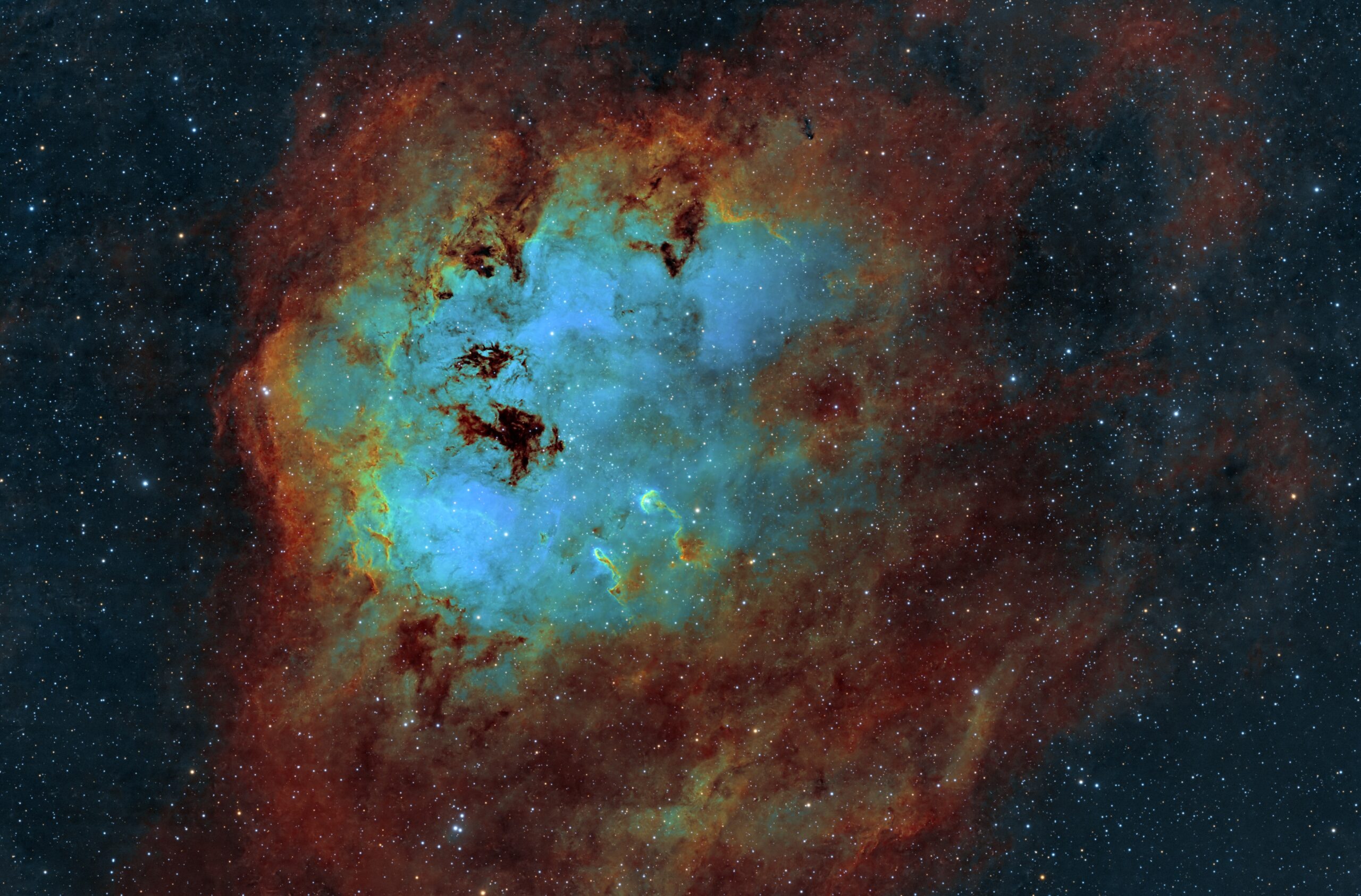 Click image for full size version
Click image for full size version
October 21, 2025
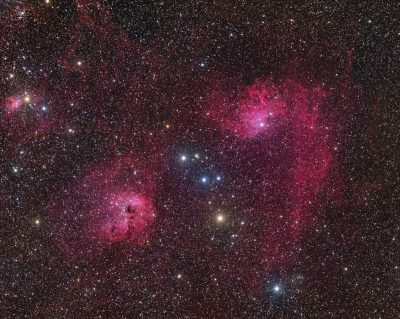 IC 410 is a dim, glowing patch of gas about 100 light years across and 12,000 light years away in the direction of Cassiopeia. The star cluster NGC 1893 is in the centre of the nebula. The “tadpoles” in the centre of th3 nebula are about 10 light years long. New stars may be forming in these structures. The dark patches in the nebula occur where dust obscures the glowing gas. The above image is rendered in the Foraxx Palette. A Hubble Palette version is here.
IC 410 is a dim, glowing patch of gas about 100 light years across and 12,000 light years away in the direction of Cassiopeia. The star cluster NGC 1893 is in the centre of the nebula. The “tadpoles” in the centre of th3 nebula are about 10 light years long. New stars may be forming in these structures. The dark patches in the nebula occur where dust obscures the glowing gas. The above image is rendered in the Foraxx Palette. A Hubble Palette version is here.
At left, a natural-colour image shows IC 410 in a larger field with IC 405 and IC 417.
Tekkies:
Acquisition, focusing, and control of Sky-Watcher Wave 150i mount and other equipment with N.I.N.A. and Green Swamp Server. Guided with PHD2 using a Sky-Watcher 50mm EDX guide scope and QHY5 II L guide camera. Focus/rotation with Primalucelab 3″ ESATTO/ARCO. Equipment control with Primalucelab Eagle 6 Pro computer. All pre-processing and processing in PixInsight. Acquired from my SkyShed in Guelphunder average transparency and seeing and little to no moonlight from September 12 to October 19, 2025.
Sky-Watcher Esprit 120 refractor, QHY168C Pro camera, Optolong filters
L-Synergy Filter: 146 x 5m = 12hr 10m
L-eXtreme Filter: 181 x 5m = 15hr 05m
Total: 27hr 15m
Preprocessing: The WeightedBatchPreProcessing script was used to perform calibration, cosmetic correction, weighting, registration, local normalization, integration and Drizzle integration of all frames (Fast Drizzle, Scale=2x, Drop Shrink=0.9).
Gradient Removal: DynamicBackgroundExtraction was applied to the two masters (L-Synergy = SOO; L-eXtreme = HOO).
SHO Master Creation: The DBExtract script was use to create S, H and O masters from HOO and SOO. The S, H, and O were combined using ChannelCombination with S assigned to red, H to green and O to blue.
Deconvolution: BlurXterminator was applied to the SHO image using an automatic PSF, star sharpening set to 0.50, and non-stellar sharpening set to 0.9.
Linear Noise Reduction: NoiseXterminator was applied with Amount=0.95 and Detail=0.5
Stretching: HistogramTransformation was applied to make a pleasing yet bright image. Approximate background level after stretch was 0.10
Nonlinear Processing
Star Removal: StarXterminator was used to remove the stars, with Unscreen selected.
Nonlinear Noise Reduction: NoiseXterminator was applied with Amount=0.9 and Detail=0.25
Contrast Enhancement: HistogramTransformation was used to adjust brightness and black point. LocalHistogramEqualization was applied twice. A Contrast Limit of 1.5 and 1 iteration was used for each LHE application (scale 40, strength 0.25; scale 150, strength 0.28). ExponentialTransformation was applied.
Sharpening: A mask that selected just the brightest parts of the nebula was used with MultiscaleMedianTransform to sharpen Layers 2 – 5 with strengths of 0.03, 0.03, 0.03, and 0.02, respectively.
Foraxx Palette Image Creation: The S, H and O channels were extracted from the SHO starless image and combined using the Foraxx Palette Utility script.
Contrast, Brightness and Colour Adjustment: Brightness, contrast, hue, and saturation were adjusted in several iterations using CurvesTransformation, ExponentialTransformation and the Jurgen Terpe Selective Color Correction script, with masks as required.
Star-only Processing: Magenta stars were corrected in three steps. 1) The stars-only image was inverted. 2) SCNR was applied. 3) The image was inverted back to its original state. The lightness was extracted from the stars-only image and used to make a mask. Colour in the stars was boosted through the mask with two applications of CurvesTransformation’s Saturation tool. Star sizes were reduced slightly with the StarReduction script.
Star Restoration: PixelMath expression combine(starless, stars, op_screen()) was used to combine the starless and stars-only images.
Final Steps: Background, nebula and star brightness, contrast and saturation were adjusted in several iterations using CurvesTransformation with masks as required. ICCProfileTransformation (sRGB IEC61966-2.1; Relative Colorimetric with black point compensation) was applied prior to saving as a jpg. The finder chart was made using the FindingChart process.

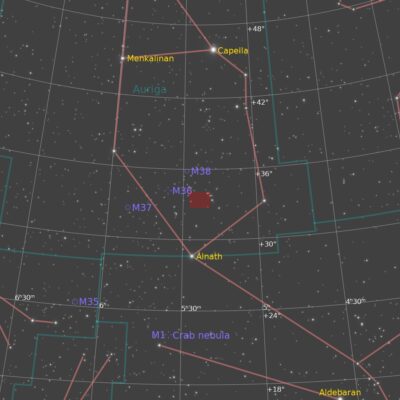
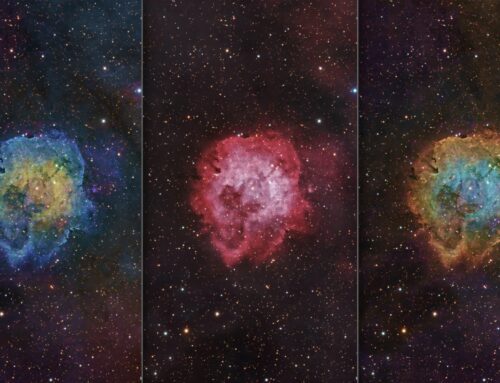
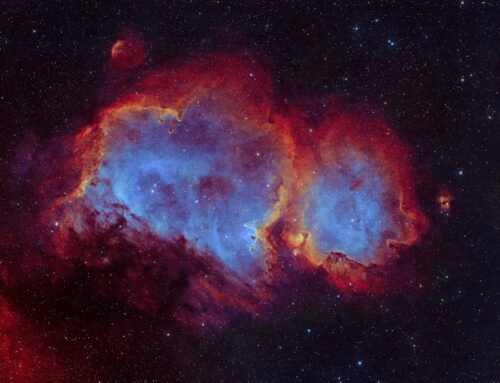

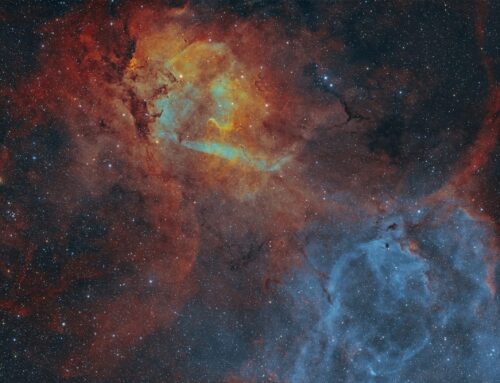
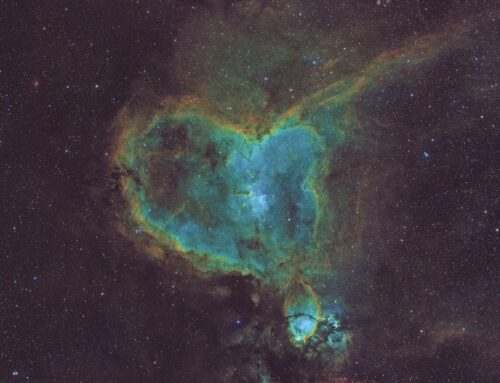
Leave A Comment